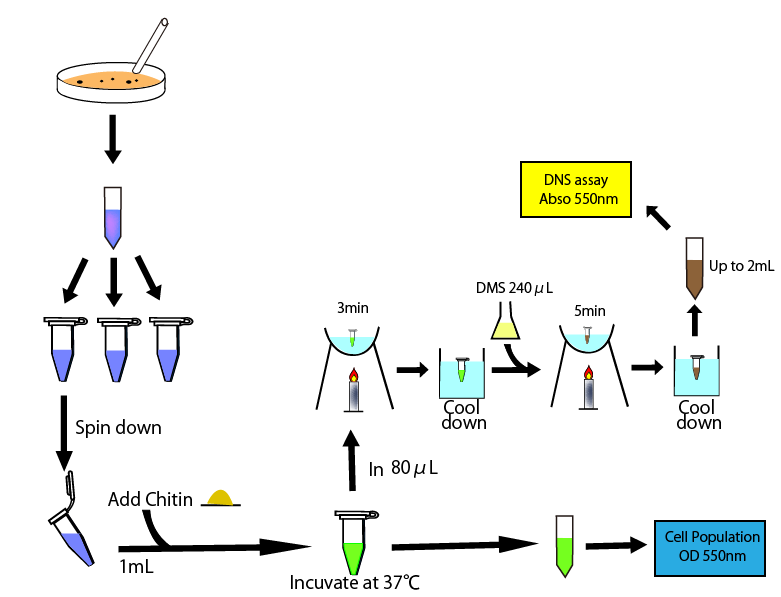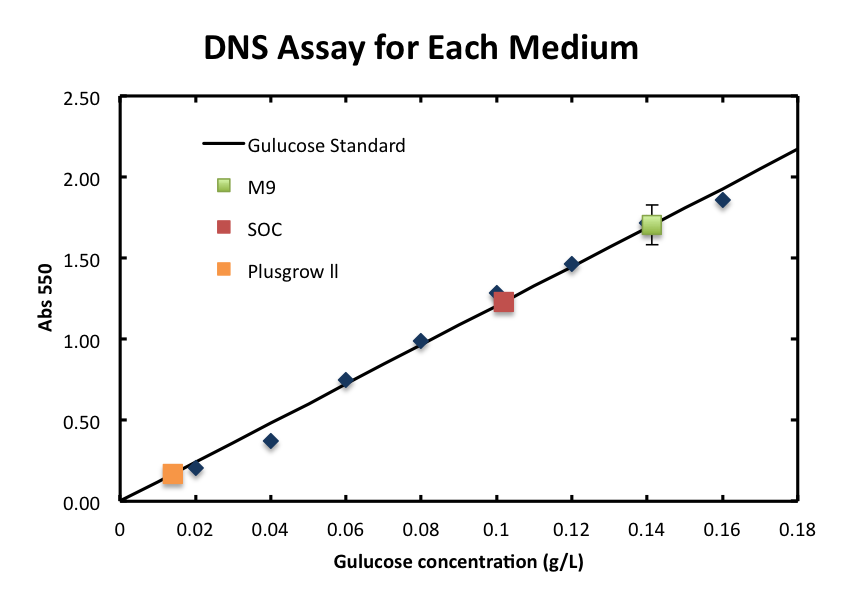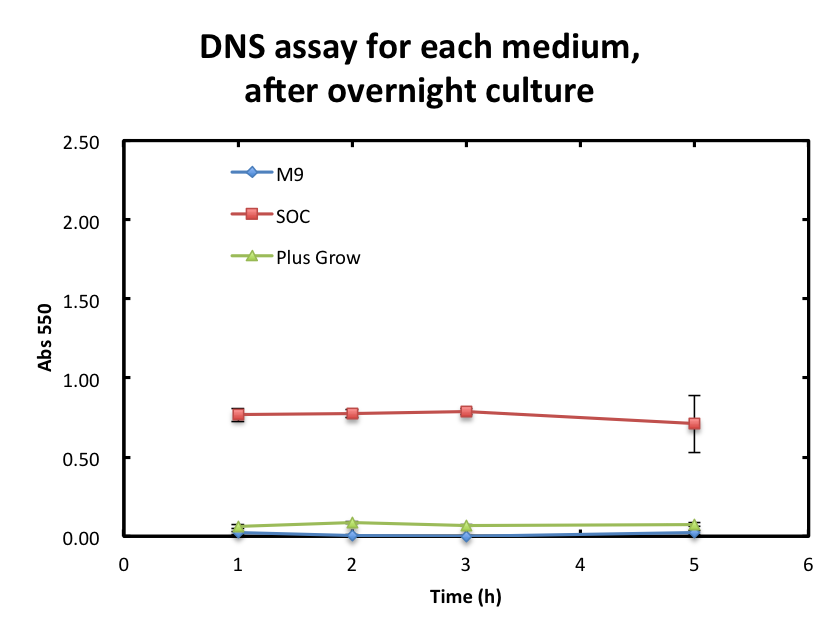Team:Kyoto/Digestion
From 2011.igem.org
Contents |
Project Digestion
Introduction
An insect body is covered with a hard integument containing mainly chitin. To decompose the integument, we used ChiA gene, which encode chitinase. In order to measure the chitinase activity of the culture supernatant, we evaluated the effects of the medium and cell growth.
Streptomyces is a kind of prokaryotic bacteria which decompose bodies in nature[1]. We extract chitinase gene from this bacterium and introduce into Escherichia coli. Secretion-signal sequences are included in this gene so that the protein coded by them will go out without occurring cell lysis. After assembling all genes, we examined the activity of this enzyme in quantitative way.
Method
Construction
We created following construction to allow secretion of chitinase, chiA1. This gene is regulated by strong lactose promoter, BBa_R0011. We used Streptmyces’s RBS into this constructions, because reference article [1] used that to allow E.coli to secrete the protein.
Assay
We performed 3,5-Dinitrosalicylic acid assay (DNS assay), because this assay takes a little time, costs a little money and was used in the previous article measuring chitinase activities [1]. DNS assay is based on this fact: 3,5-dinitorosalicylic acid (DNS), whose color is yellow, reacts with reducing saccharide by boiling and changes into 3-amino-5-nitorosalicylic acid, whose color is brawn.
The more the amount of reducing sugar is, the more this coloring reaction proceeds. We can quantitatively evaluate the degree of this coloring reaction by measuring OD 550, because OD 550 is in direct proportion to the amount of reducing sugar.
We will react DNS reagent with the media where chitin and E.coli introduced chitinase gene are added. If chitinase is secreted in media, chitin is decomposed into reducing sugar, for example, N-acetylglucosamin and coloring reaction proceeds. Therefore, by measuring OD 550, we can indirectly measure chitinase activities.

Result
To measure chitinase activity by DNS assay, we thought to need four following things to get accurate result. We need
- to plot the relationship of reducing sugar concentration and OD 550
- to evaluate the impact of components of media on OD 550
- to evaluate the impact of remeineded E.coli in media on OD 550
- to measure chitinase activity
To plot the relaionship of reducing sugar concentration and OD 550
- First, to measurement quantitatively, we need the relationship to reducing sugar concentration and OD 550. It is known that this relationship can be plotted in linaer. This experiment was written in experiment1
To evaluate the impact of components of media on OD 550
- Second, to get accurate values of OD 550, we need to evaluate the effect of components of medium on OD 550. the compounds such as glucose ma react with DNS reagent. Moreover, the color of medium itself may affect the value of OD 550. To assess and correct this impact, We preformed experiment2.
To evaluate the impact of remaineded E.coli in media on OD 550
- Thrid, to get also accurate values of OD 550, we need to evaluate the effect of remaineded E.coli in medium on OD 550. If too much E.coli exist in medium, They may consume glucose or N-acetylglucosamin in media and we can't measure correctly chitinase activity. To assess and correct this impact, We preformed experiment3.
To measure chitinase activity
This figure shows the overall of DNS assay

1. Standard Measurement for ChiA1.
- From the result, a strong correlation between glucose concentration and its A550 was observed.
2. Consideration of medium and growth of E.coli.
- We checked the influence of each medium to the DNS assay. Figure 4 shows the background absorbance of each medium. The absorbance of M9 was 1.7±0.1, SOC was1.227±0.007, and Plusgrow Ⅱ was 0.17±0.02.
- We also checked the culture supernatant if it would affect to the absorbance. Figure 3 shows the absorbance of each culture supernatant
Discussion
and remained E.coli interruption. Perhaps, medium supernatant contains some compounds reducing 3,5-dinitorosalicylic acid and E.coli which remain there even after centrifusion. These effects can cause error in the value of absorbance. Reducing substance can react with 3,5-dinitorosalicylic acid and change the color of the supernatant. E.coli may consume reducing sugars derived from chitin and prevent 3,5-dinitorosalicylic acid from reducing reaction. In order to estimate the extents of these tow effects and build the most appropriate experiment system, we conduct these following assays.
The results of this measurement and the fig 1 graph enabled us to calculate the amount of digested chitin, showing the relative activity of chitinase.
To overcome these barriers, we decided detail plan of our assay. From the result fig 3, SOC medium cultured E.coli overnight would still include too much amount of reducing materials and, from fig 3. plas-grow enabled reminded E.coli to grow rapidly. However, as for M9 medium, the increase of absorbance was lowest and there were fewest E.coli after 5 hour culture. So we choose M9 as the medium we will used in our assay. Another barrier, interruption of remained E.coli, can be avoided by the following way, conducting DNS assay before chitin is applied and after chitin is decomposed. The difference of these two assays’ data will show the real activity of chitinase.
Reference
[1] “Actinobacteria.” Internet: http://en.wikipedia.org/wiki/Actinobacteria [Nov. 5, 2011]
[2] H. Ikeda, J. Ishikawa, A. Hanamoto, M. Shinose, H. Kikuchi, T. Shiba, Y. Sakaki, M. Hattori, S. Omura, “Complete genome sequence and comparative analysis of the industrial microorganism Streptomyces avermitilis.” Nat Biotechnol., vol. 21, no. 5 pp. 526-31, Apr. 2003
[3] S. Omura, H. Ikeda, J. Ishikawa, A. Hanamoto, C. Takahashi, M. Shinose, Y. Takahashi, H. Horikawa, H. Nakazawa, T. Osonoe, H. Kikuchi, T. Shiba, Y. Sakaki, M. Hattori, “Genome sequence of an industrial microorganism Streptomyces avermitilis: deducing the ability of producing secondary metabolites.” Proc Natl Acad Sci U S A. vol. 98, no. 21 pp. 12215-20, Oct. 9
[4] H. Sakuzou, ”還元糖の定量法(生物化学実験法)” Kyoto University: Japan Scientific Soceties Press
[5] S. Kongruang, M. J. Han, C. I. Breton, M. H. Penner, “Quantitative Analysis of Cellulose-Reducing Ends.” Appl Biochem Biotechnol. Vol. 113, no. 116 pp. 213-31, Spring 2004
 "
"











